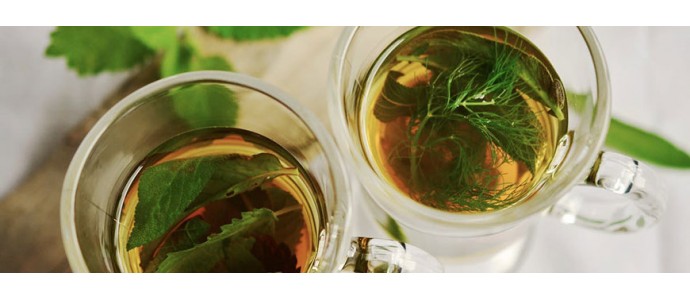How to create your own herbal apothecary

The history of using herbs spans over centuries. However, due to technological progress, we have forgotten about their amazing properties, and turned to synthetic medicine instead. Fortunately, these days more people discover the extraordinary healing power of the common plants all over again, seeking a way to live a healthier life closer to nature.
It's hard to pinpoint which herbs should be included in every household’s herbal medicine cabinet as it depends on individual needs and taste preferences. However, there are a few staples that should be considered while creating your own herbal apothecary.
The simplest way to use them is by steeping them in hot water to make tea, however, it’s also good to know that many can be used in other forms, such as oils.
Start with the basics - check your needs
Insomnia? Digestive Problems? Weak hair and nails? What you need to do at the beginning of your herbal journey is to check your needs. After that, you can start looking for herbs that may be helpful in treating your ailments. Here are some examples of herbs you can start with.
1. Dandelion Root & Dandelion Leaf
The dandelion herb holds an incredible wealth of various biologically active compounds and substances that can support your organism.
Each part of the dandelion has different healing properties and can be used for different purposes. Dandelion Root ranks first in supporting liver ailments. Dandelion Leaves have diuretic properties, helping the body to get rid of excess water. Young leaves are suitable for salads as a source of provitamin A.
2. Stinging Nettle Leaf & Nettle Root
Many studies have been carried out on the chemical composition of nettle that has shown the presence of many biologically active compounds, both in the roots and leaves of the Stinging Nettle. These ingredients replenish missing substances in the body that are necessary for proper metabolism, i.e. vitamins. It is helpful in increasing body water retention, works against hair loss, lowers blood pressure, and detoxifies the body.
Chamomile has anti-inflammatory, antispasmodic, antiallergic, and calming properties. It helps to heal inflammation of the skin, wounds, burns, as well as in the care of sensitive skin. It also aids in states of exhaustion and nervousness. Chamomile Flower tea has a calming effect and can be used as a sleep aid. You can drink it with the addition of honey and lemon, thus helping to heal a runny nose and cough or to get ready for bed in the evening.
Its healing properties have been known for centuries. Horsetail Herb is a rich source of flavonoids, organic acids (especially silica), and mineral salts. It also replenishes the deficiencies of elements such as magnesium and potassium. Horsetail may aid in excessive sweating of the feet, brittle nails, and hair loss.
5. Sage Leaf
Sage was known as a medicinal plant since ancient times and is now cultivated in many countries. It has antibacterial and antifungal properties. Sage Leaf infusions are used externally (for rinsing) in inflammations of the mucosa of the mouth and throat, and in some cases skin disease. Internally, it aids in excessive sweating and in gastric catarrh conditions.
Linden Flower is a well-known and valued natural medicinal product. It is a component of many preparations - teas and syrups, most often used in cold and flu. It is also an effective method of treating inflammation in the oral cavity. The infusion made of Linden Flowers has a mild and pleasant taste.
Eyebright Herb has been used as a mild astringent since the Middle Ages. Eyebright infusions are suggested when one suffers from the inflammation of the eyes or the edges of eyelids. They are especially useful for tired eyes. That herb is also a component of eye creams because it helps to brighten shadows under the eyes, lessen the appearance of eye bags, and reduce the visibility of capillaries.
8. Common Mallow Leaf & Flower
The most valuable component of Common Mallow Leaf is mucus. Thanks to its presence, the mallow is used as a protective measure both in inflammation of the respiratory tract and the throat. Common Mallow Flower infusion helps to relieve discomfort in the mouth and throat and facilitates expectoration.
The unique scent of Lavender has a relaxing effect on the body and soul. It removes stress and tension, and it is known that these two faithful companions can have a devastating effect on the entire body. Lavender Flower relieves the physical symptoms caused by stress: tension headaches, migraines, sleep problems. It also has a bactericidal effect.
Greek Mountain Tea infusion is a source of zinc, magnesium, potassium, sodium, and iron. It helps in increasing our natural immunity, which is why it is especially recommended in the autumn and winter period. Since the Greek Mountain Tea has anti-inflammatory and antibacterial properties, it is recommended for all symptoms of colds, flu, as well as inflammation of the upper respiratory tract.
Traditional herbal preparations have been used by herbalists and pharmacists for centuries. Their healing and regenerating properties are impressive. Herbal infusions are also a great alternative to everyday drinks like black tea and coffee. However, it is worth remembering that many herbs can also be used for body care, hair rinsing, bathing, and washing, and not only for preparing tea infusions. To get the best possible use of any given herb, make sure to dedicate some time to learn about its properties and how to use it first. You may be surprised at how many benefits you can get from popular and widely available plants.

Comments
Leave your comment